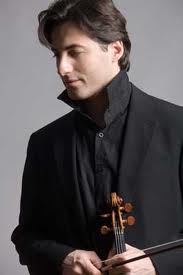
Chamber Orchestra Conjures Jefferson's Time

Philippe Quint
|
What do you do on a Saturday night?
If you were violinist Philippe Quint on Saturday, Oct. 29, you . . .
listened to Turkish military bands on YouTube.
???
Quint posed that very question -- and answer – as soloist with the Cincinnati Chamber Orchestra Oct. 30 in Mayerson Theater at Erich Kunzel Center for Arts and Education.
Why became clear when, after asking for some rhythmic clapping from the audience, Quint launched into an improvisation, Turkish style. It was the encore following his performance of Mozart’s Violin Concerto No. 5, the “Turkish,” so-called for an episode in the rondo finale.
Such were the good spirits on this Halloween-eve concert led by CCO music director Mischa Santora. Santora conducted and narrated the program, dubbed “Jefferson in Paris,” first concert of the CCO’s 2011-12 season, “American Perspectives.” The concert, part of the ongoing Constella Festival of Music and Fine Arts, looked at music through the ears and eyes of Thomas Jefferson. America’s third president was a fine violinist and a music lover, able to imbibe European classical music directly during his years in Paris as U.S. ambassador (1784-89).
Jefferson took a violin with him on his travels and practiced daily, said Santora, who read from Jefferson's letters and other accounts of his time. He certainly would have known and played music by Archangelo Corelli, the 17th-century violinist/composer who laid the foundation for the Italian school of violin-playing. The concert opened with Corelli’s Op. 5, No. 12, originally a sonata for violin, arranged by Francesco Geminiani for concerto grosso (a small group of soloists with instrumental accompaniment). The work, one of his best known, consists of 24 variations on “La folia,” a theme, originally Portuguese, popular throughout music history (it means “madness”). Soloists were CCO concert mistress Anna Reider, principal second violinist Manami White and principal cellist Patrick Binford. Their performance was refreshingly baroque, with limited or no vibrato, clarity of line and precise rhythmic definition.
Although
there were no Mozart scores in Jefferson’s library (according to Santora), he
would have heard Mozart’s music, since his violin concertos date from that
period. The Fifth Concerto is the most
delightful, perhaps, with its colorful finale.
Quint’s reading was not subtle, but full-voiced and expansive, operatic in
the Adagio, which, as in the opening Allegro, included an extended cadenza
(Quint’s own). He invested the outer movements
with singing tone and considerable personality (as reflected in his body
language, whether performing or not). He
and Santora, himself a violinist, worked very well together, exchanging signals
precisely. (Quint sneaked a quotation from Mozart's "Eine kleine Nachtmusik" into his "Turkish" encore.)
The reason for Charles Ives’ “Three Places in New England” (1903-29), which opened the second half, was referential, said Santora. The first two movements, “The St. Gaudens in Boston Common” and “Putnam’s Camp,” recall America at war (to which Jefferson could relate in no small way). The final movement, “The Housatonic at Stockbridge,” is atmospheric, something Jefferson the farmer could also relate to. All three were given expressive readings: solemn and distant-sounding in “St. Gaudens” (which memorializes a black regiment that fought in the Civil War), raucous in “Putnam’s Camp” (named for a Revolutionary War general) and filled with gentle beauty in “Stockbridge.”
Santora closed with Haydn’s Symphony No. 82 in C Major, “The Bear,” a work composed and performed in Paris in 1786 (during Jefferson’s time, Santora noted, speculating whether the two might have met.) The CCO, which has adopted Mayerson as its new performance home, played with great precision, a plus in Mayerson with its crystal clear (but unforgiving) acoustics. There was abundant jollity in the Menuet, while the Finale was swift and jubilant, its recurring drone reminiscent of the hurdy-gurdy (bowed stringed instrument that can imitate bagpipes). Hence the Symphony’s nickname, “The Bear,” since bears were trained to dance to such music as a form of popular entertainment at the time.
The Constella Festival closes with a recital by violinist Joshua Bell at 7:30 p.m. Nov. 8 in Memorial Hall.